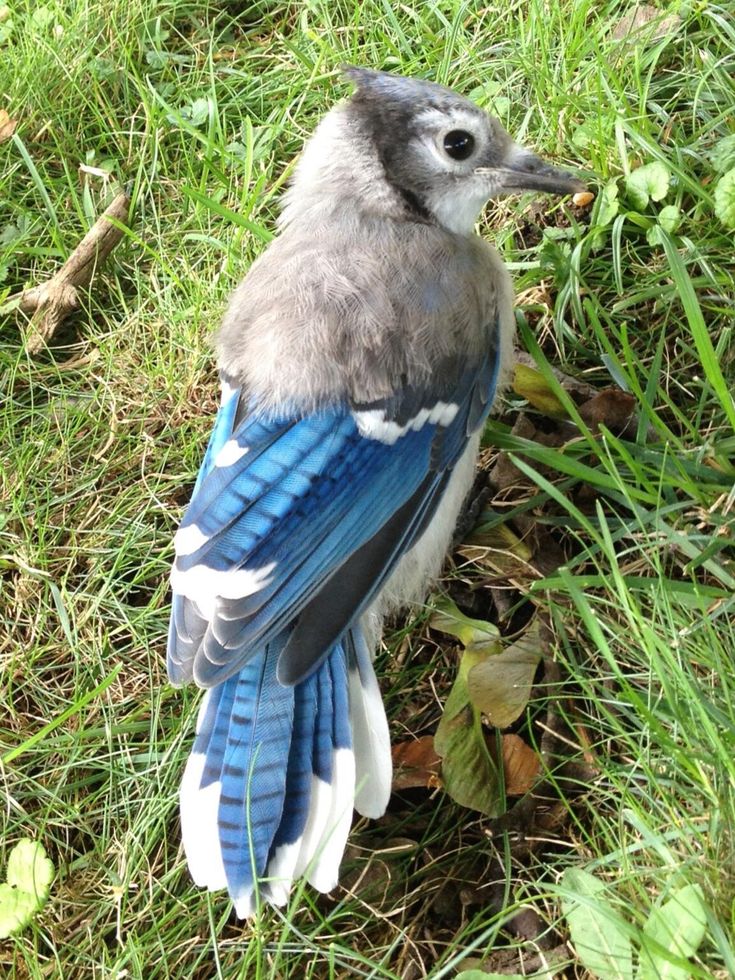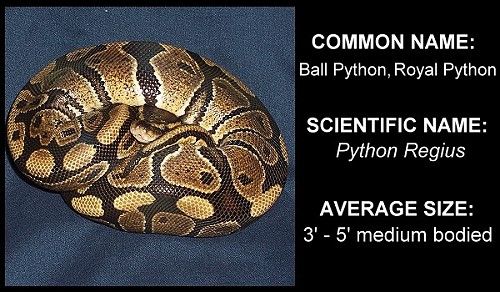Blue jay baby food
Baby Blue Jays: All You Need To Know
What does a baby Blue jay look like?
How big are baby Blue jays?
Why do you never see baby Blue jays?
What is a baby Blue jay called?
What do baby Blue jays eat?
Do both parents feed baby Blue jays?
What do Blue jay eggs look like?
How long do Blue jay eggs take to hatch?
How many babies does a Blue jay have?
When do Blue jays lay eggs?
How do Blue jays feed their chicks?
How long do baby Blue jays stay with their parents?
Do Blue jays have helpers?
Blue jays (Cyanocitta cristata) have beautiful cobalt-blue plumage and distinctive head crests - they’re the most colorful of all the corvids and one of the most recognisable birds in North America.
Like all corvids, Blue jays are intelligent and resourceful, but what about baby Blue jays? This is a guide to everything you need to know about baby Blue jays!
What does a baby Blue jay look like?
Baby Blue jays are tiny when they hatch and are mainly grey with faint shades of yellow and pink. They’re blind with closed eyes and may be covered in small featherless naked patches.
At hatching
Baby Blue jays are mostly feathered when they hatch but may have naked featherless patches. They’re predominantly grey with pink/yellow plumage on their underside. Their eyes are shut and don’t open for the first 4 to 5 days.
While baby Blue jays will only squirm on their first day, they can shuffle around the nest by day 2. Blue jay hatchlings are tiny, just 50mm long or so.
Blue jay feeding chicks in the nest
Growth and development
Blue jays grow rapidly in their first five days, and their plumage gets noticeably darker, turning to olive. Blue feathers don’t start breaking out until day 14 or so and continue to grow until day 20 or so, at which point the jay fledges.
Full blue plumage development isn’t complete for another month or so after fledging. However, juvenile Blue jays are relatively easy to identify by their blue-grey plumage and buff, fluffy feathers.
A pair of recently fledged blue jays
How big are baby Blue jays?
Baby Blue jays weigh around 5.5g at hatching with a body length of just 51 mm. By the fifth day, Blue jays already weigh approximately 20 to 28g and measure about 76 mm.
Why do you never see baby Blue jays?
Baby Blue jays won’t leave the nest for 17 to 22 days but are unable to fly for another week or so after fledging.
Once fledged, the chicks remain close to their parents. The parents often relocate away from the nest while staying within the confines of deep treetop foliage.
Blue jay fledglings are vulnerable and are pretty easy to spot if they’re roaming around on the ground. However, if you spot one, its parents are probably watching it (and you!) from a treetop perch, so think twice before touching or relocating it.
A blue jay fledgling on the ground
What is a baby Blue jay called?
There is no specific name for baby Blue jays. Just after they hatch, Baby Blue jays are called hatchlings. Then, they develop into nestlings while they spend all of their time in the nest. Finally, baby Blue jays become fledglings, juveniles, and fully grown adults.
Then, they develop into nestlings while they spend all of their time in the nest. Finally, baby Blue jays become fledglings, juveniles, and fully grown adults.
What do baby Blue jays eat?
Baby Blue jays eat whatever their parents bring them, including insects, berries, seeds and grains. While Blue jays also eat meat in the form of small animals and other birds, the young are unlikely to be able to digest it. Soft foods are preferable.
In the first few days after hatching, the male provides the vast majority of food, but the female will join if his haul is insufficient. Then, after a few days, the female typically joins the male to forage more feed for the hungry chicks.
After that, the male usually feeds the nestlings too, but the female has been observed reaching into the chicks’ mouths and redistributing food.
A blue jay feeding one of their chicks
Do both parents feed baby Blue jays?
In the first few days after hatching, the male does most of the foraging and feeds the nestlings.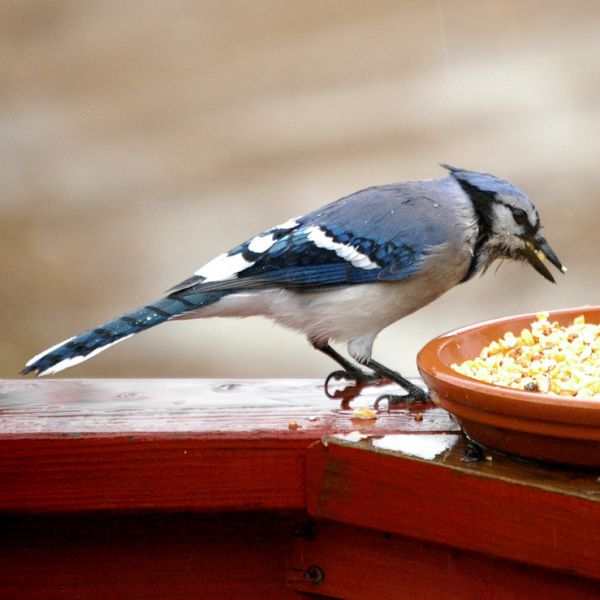 However, the female will often forcibly redistribute food by reaching into the nestlings’ mouths.
However, the female will often forcibly redistribute food by reaching into the nestlings’ mouths.
After around 4 to 5 days, the female typically joins the male. As the birds approach fledging, both birds feed the chicks. Parental feeding carries on for a week or two after the baby Blue jays fledge.
What do Blue jay eggs look like?
Blue jay eggs typically measure 28 mm x 20 mm and are predominantly ovular. colors vary from shades of blue, to green, olive and light brown.
They’re spotted or blotched with brownish markings, mainly towards the larger end. So while Blue jay eggs look similar to most corvid eggs, they vary a lot, especially regarding their color and shape.
A juvenile blue jay, perched on the fence
How long do Blue jay eggs take to hatch?
Blue jay eggs are incubated for around 17 to 18 days before hatching.
How many babies does a Blue jay have?
Female Blue jays typically lay between 2 to 7 eggs, but 4 to 5 is more common. It would be rare for all chicks to survive until adulthood.
It would be rare for all chicks to survive until adulthood.
When do Blue jays lay eggs?
Blue jays almost solely lay eggs in the months of March, April and May.
May egg-laying usually only occurs in the north, or when it’s particularly cold. In the south, egg-laying may start as early as early March, but rarely earlier.
- Michigan: early May
- Minnesota: late April
- Kentucky and Kansas: Mid April
- Arkansas: late March
- Florida: Early March
Three Blue Jay fledglings perched in a tree together
How do Blue jays feed their chicks?
Blue jay parents are presumed to partially regurgitate harder foods into the chicks' mouths, but probably feed most foods to the chicks whole. Larger pieces of food will be torn up before feeding.
Baby Blue jays are fed with berries, insects and seeds. Insects are ideal as they’re soft and high in protein and fats.
How long do baby Blue jays stay with their parents?
Blue jays fledge after just 17 to 21 days after hatching in most cases, but they’ll stay very close to the nest (within 25m or so usually) for another 2 to 3 weeks.
After that, young Blue jays usually stay within the family unit for another 2 to 3 months, at which point they’ve grown out most of their adult plumage and fly off to establish independent territories. Baby Blue jays often continue to harass their parents for food long into summer.
Close up of a baby blue jay
Do Blue jays have helpers?
Helpers are single unpaired birds that help a pair of birds with everything from nest building and incubation to brooding and feeding.
Blue jays sometimes have nest helpers, though this is rarer than it is for other Corvids, e.g. crows.
Blue jay helpers have been observed helping build the nest and feeding the young. It’s unclear whether they’re related to the pair (e.g. last year’s young), or whether they’re unrelated.
Expert Q + A
Question
When are baby blue jays most vulnerable to cats?
BirdFact Team
Generally speaking, baby blue jays are most likely to be predated by cats when they are in the nest - particularly whilst on the rim of the nest, and for the first few days after they fledge the nest.
Blue Jays can be pretty aggressive when it comes to defending their nests, which can often scare the predators away. With cats, similar to other predators, the parents usually will mob the cat in an attempt to scare it away and protect their young.
Ask a question
Do you have a question about this topic that we haven't answered? Submit it below, and one of our experts will answer as soon as they can.
What Do Baby Blue Jays Eat?
by Jesse
Blue jays are an easily recognizable, perhaps even iconic, songbird. Their large size, blue feathers, and distinctive call mean that just about anyone can recognize a blue jay. Adults can often be seen eating large acorns, and are drawn to feeders full of things like peanuts and sunflower seeds. They also have been known to occasionally raid the nests of other birds, eating their eggs and chicks. So we know what adult blue jays eat, but what do baby blue jays eat?
What Do Baby Blue Jays Eat?
As with most birds, baby blue jays eat more or less the same things that their parents eat.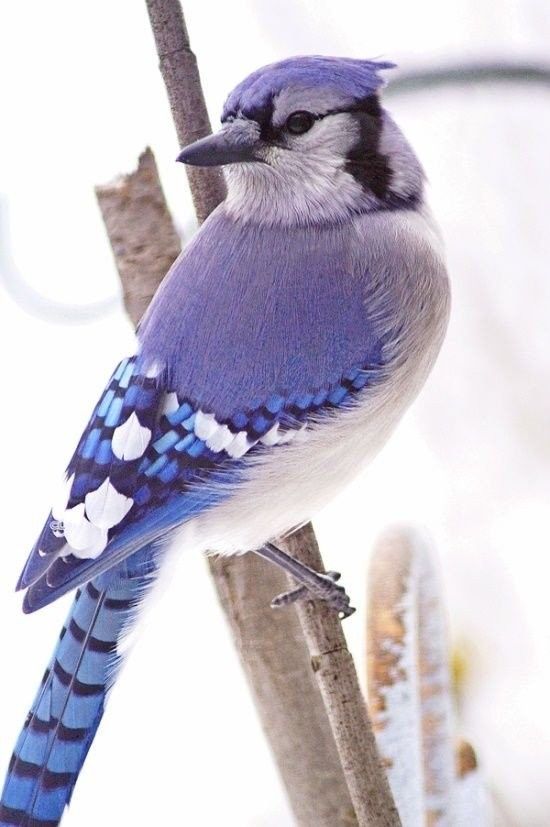 Adult blue jays bring nuts, seeds, insects and small animals back to the nest for their chicks. For at least six weeks after hatching, the chicks are totally dependent on their parents to bring them food, and the parents bring whatever they can find.
Adult blue jays bring nuts, seeds, insects and small animals back to the nest for their chicks. For at least six weeks after hatching, the chicks are totally dependent on their parents to bring them food, and the parents bring whatever they can find.
Do Baby Blue Jays Eat Worms?
If their parents bring them a worm, they’ll eat it. Caterpillars and seeds are probably more common, but earthworms certainly make their way into many baby blue jay’s diets. Worms are a little hard to find, since they’re usually underground, but occasionally a heavy rain or human activity brings a bunch of worms to the surface, and the blue jays will definitely go after them. The parents must also take size into consideration, very young nestlings often cannot yet eat large earthworms.
How to Feed Baby Blue Jays
If you need to feed a baby blue jay, use either moist dog/cat food or commercially sold baby bird food, fed through an eye dropper. However in general you should not attempt to do this yourself, and we will talk about why below.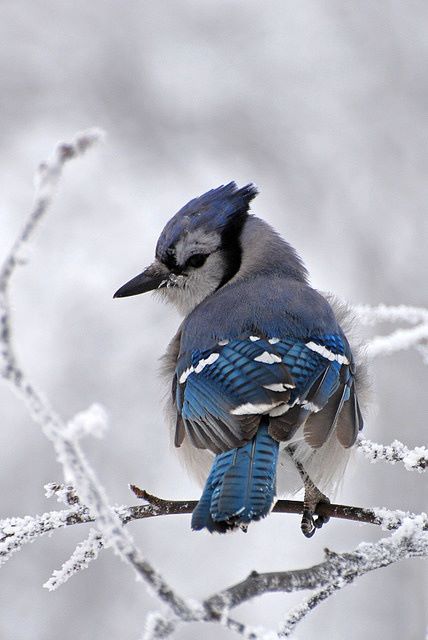
If you’ve found a nest with baby blue jays you suspect is abandoned, don’t jump to any quick conclusions. In most cases of a nest with begging babies, the adults are nearby finding food and will come back periodically to feed the young. Male and female blue jays both take turns feeding the young, however it has been observed that males may often do the majority of the feeding.
Some feedings can be very quick, and the adults will only stop by for a minute before leaving to find food again. Because you could easily miss this quick process, you would have to watch a nest non-stop (not a few minutes at a time) for at least a few hours before you could determine if the babies have potentially been abandoned.
Contacting a Wildlife Rehab Expert
If you have determined that the baby blue jays do need help, it is important to contact a qualified bird rehabber. In many states, only certified rehab specialists are allowed to be in possession of wild birds. Not to mention they are trained in exactly how to care for them.
Care of baby birds can be very tricky. Many nestlings need to be fed every 20 minutes or so for 12 to 14 hours a day! That is a lot of constant time and attention. They also need balanced food with enough protein and nutrients to grow properly. This is why the knowledge and expertise of a rehabber is their best bet for survival.
If you get in touch with a rehabber that isn’t able to take the birds right away, they may instruct you on how to care for them until they can pick them up. For the short term, dog or cat food (moist, fed through a dropper), or specialty baby bird food mix, is often used.
To find a rehabber near you, Google search the name of your state plus “wildlife rehabilitation”, or check your states department of the environment page for a list of licensed rehabbers.
Do Blue Jays Really Raid Other Bird’s Nests?
This is a widely held belief, and it’s not entirely clear why this is so commonly believed. In fact, there’s not really much evidence to suggest that blue jays are nest-raiders. In a study performed on blue jay diet that looked at their stomach contents, researchers found remains of eggs or nestlings in only 1% of adult blue jays, which hardly makes them stand out as “egg snatchers” over other birds.
In a study performed on blue jay diet that looked at their stomach contents, researchers found remains of eggs or nestlings in only 1% of adult blue jays, which hardly makes them stand out as “egg snatchers” over other birds.
While blue jays are not big nest-raiders themselves, they have to be on guard against other birds. Crows, especially, will eat blue jay eggs or kill and eat their chicks.
Why Did a Blue Jay Attack Me?
Despite the fact that they are somewhat small in the world of wildlife, blue jays are surprisingly aggressive and fearless. Plenty of people have been attacked by angry blue jays, and most of them were just walking down the street or in their yard when it happened. Fortunately blue jays aren’t really capable of doing any damage, but it’s still an unnerving experience.
In all likelihood, if you’re dive bombed by a blue jay, you were walking too close to their nest. Blue jays like to build their nests high up in trees and they hide them well, so it’s rare to spot them. The parents, though, are fierce protectors and won’t hesitate to chase of potential predators.
The parents, though, are fierce protectors and won’t hesitate to chase of potential predators.
This is especially true around May and June, when the babies are just learning to fly. This is when they’re at their most vulnerable, and the adults get extra protective of them. That’s when most blue jay attacks occur.
Do Blue Jays Like Acorns?
Acorns are a favorite food of blue jays, although they’re a bit too big for the babies to eat. That’s fine, since by the time acorns are available the babies will have left the nest and grown to adult size. Acorns are a favorite for blue jays, and each fall adult birds will hide somewhere between 3,000 and 5,000 acorns in the ground, saving them for the winter months.
In fact, blue jays are credited with spreading oak forests across the U.S. While they remember where they put most of those acorns, they always forget some of them, which means that each blue jay ends up planting a bunch of oak trees every fall.
Conclusion
Baby blue jays eat just about anything their parents bring them. Mostly, that means seeds, nuts, and insects. If you find yourself caring for baby blue jays that have been abandoned while waiting for help from a rehabber, pet food or commercially sold baby bird food will help to meet their nutritional needs.
Mostly, that means seeds, nuts, and insects. If you find yourself caring for baby blue jays that have been abandoned while waiting for help from a rehabber, pet food or commercially sold baby bird food will help to meet their nutritional needs.
About Jesse
Jesse enjoys bird watching and feeding birds in his backyard, learning about the different species, and sharing his knowledge and experiences.
...
Blue Jay - Corvidae | Non-commercial educational and cognitive Internet portal Zoogalaxy
6064 6065 6066 8409 8410 8411 863Habitat
The range of blue jay ( Cyanocitta cristata ) extends from the eastern United States and southern Canada to the Gulf of Mexico. Most of the birds living in the north of the range migrate to the south in winter. The migration takes place during daylight hours in flocks of 5-50 birds and more (flocks of up to 3000 birds have been observed).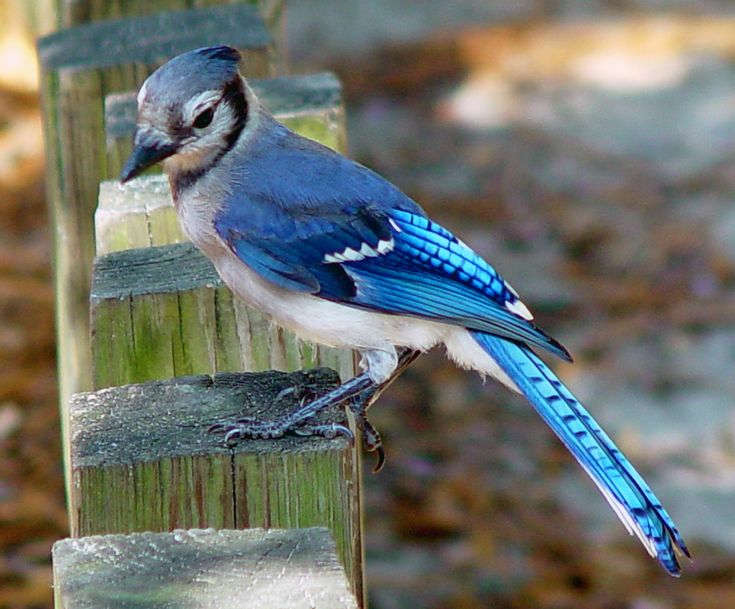 Blue jays inhabit a wide variety of habitats - deciduous forests, parks and gardens, suburban residential areas. But still they prefer mixed oak and beech forests, however, in the west of the range they can also be found in dry pine forests and shrubs.
Blue jays inhabit a wide variety of habitats - deciduous forests, parks and gardens, suburban residential areas. But still they prefer mixed oak and beech forests, however, in the west of the range they can also be found in dry pine forests and shrubs.
Description
The body length of these beautiful birds reaches 30 cm, wingspan - about 42 cm, weight ranges from 70 to 100 g. The blue jay has a blue back, a long bright blue crest, a black necklace, a blue-black-and-white pattern on the wings - white striped tail. Females and males are colored the same, but males are somewhat larger. Their beak is strong, thanks to which jays easily split seeds with a hard shell. These birds can make a wide variety of sounds, such as melodious whistles and bell-like sounds; they imitate the calls of the hawk; shout loudly, warning of the approach of a predator; the pair, communicating with each other, makes a sound similar to the work of a rusty pump. Sometimes jays imitate hawks to deceive other birds and drive them away from their food.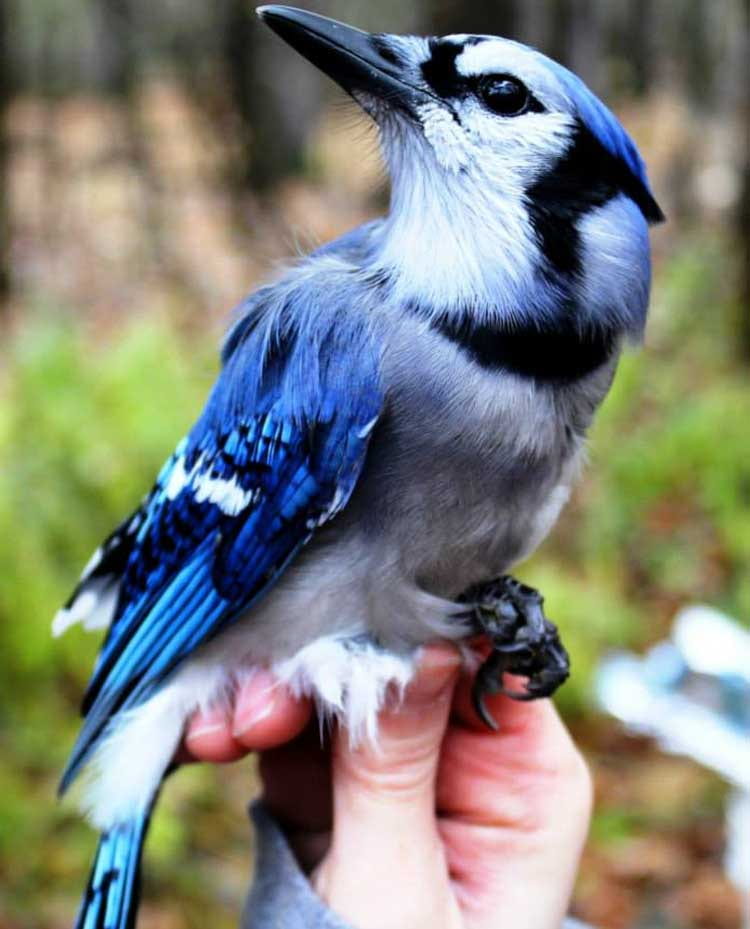 They are excellent imitators, in captivity they quickly learn to imitate human speech.
They are excellent imitators, in captivity they quickly learn to imitate human speech.
Nutrition and behavior
Blue Jays are social birds, they live in pairs, small family groups or flocks. Jays are omnivorous, their diet includes both vegetable (acorns, beech nuts, seeds and fruits, berries - up to 78%) and animal feed (beetles, grasshoppers, spiders, centipedes, caterpillars, small vertebrates - chicks and eggs, lizards and frogs, mice - up to 22%), as well as carrion. Blue jays often steal prey from other birds. Non-migratory individuals make stocks for the winter, for example, acorns and seeds are hidden in cracks in the bark or under fallen leaves, buried in the soil. One jay in autumn can "prepare" up to 3-5 thousand acorns. At one time, this bird carries up to five acorns - it puts 2-3 acorns in the goiter, holds one in its mouth and one more in its beak.
Nesting
Blue Jays are monogamous and form permanent pairs (sometimes for life. ) Typically, nests of these birds, 18-20 cm in diameter, are located in the forks of lateral branches of deciduous or coniferous trees at a height of 3-10 m above the ground. The rods used for the outer part of the nest are broken off by birds from living trees. Jays collect various roots with which the nest is leveled in freshly dug ditches, fresh graves in cemeteries, from recently fallen trees, etc. All this is carefully laid, and sometimes sealed with moist earth or clay. The nest tray is lined with rags, wool, lichen, paper, dry leaves and grass. Before finishing nest building, birds build several incomplete nests as part of their courtship ritual. Feeding the female is also part of this ritual - flying up to the male on a nearby tree, the female takes the pose of a chick asking for food and the male feeds her. If the nest is discovered by a predator, the birds may leave it forever.
) Typically, nests of these birds, 18-20 cm in diameter, are located in the forks of lateral branches of deciduous or coniferous trees at a height of 3-10 m above the ground. The rods used for the outer part of the nest are broken off by birds from living trees. Jays collect various roots with which the nest is leveled in freshly dug ditches, fresh graves in cemeteries, from recently fallen trees, etc. All this is carefully laid, and sometimes sealed with moist earth or clay. The nest tray is lined with rags, wool, lichen, paper, dry leaves and grass. Before finishing nest building, birds build several incomplete nests as part of their courtship ritual. Feeding the female is also part of this ritual - flying up to the male on a nearby tree, the female takes the pose of a chick asking for food and the male feeds her. If the nest is discovered by a predator, the birds may leave it forever.
During the breeding season, talkative jays become very quiet.
Reproduction
In clutch they have from 2 to 7 yellow-green or bluish eggs with brown spots. Only the female incubates them for 16-18 days.
Only the female incubates them for 16-18 days.
Chicks are born helpless and blind. Mother and father feed, warm, clean and protect them. The eyes of the chicks open on the fifth day, and on the eighth day their plumage begins to grow. The female begins to fly away in search of food when the chicks are 8-12 days old. 1-3 days before departure from the nest, the chicks begin to wander along the branches of the tree on which the nest is located. But further than 4.5 m from the nest, they do not depart. They finally leave the nest only at the age of 17-21 days. In the first days, young birds do not fly away from the parental nest further than 20 m.
Until autumn, young people stay close to their parents and only in winter do they begin to lead an independent life.
Jay/Garrulus glandarius - "Experience of keeping a jay chick in captivity"
Only after saying goodbye to his bat, as in the house again appeared a helpless little creature.
Returning from training in the roadside dust, I found a moving gray, feathery lump. It was not possible to return to the nest, because. in tall trees, I simply didn’t see him, no matter how I tried, and leaving the chick to be eaten by cats is not acceptable for me. She waited about an hour on the sidelines (fortunately there was enough time), the chick began to yell, but the relatives were nowhere to be seen. So Gavryusha appeared in my family.
It was not possible to return to the nest, because. in tall trees, I simply didn’t see him, no matter how I tried, and leaving the chick to be eaten by cats is not acceptable for me. She waited about an hour on the sidelines (fortunately there was enough time), the chick began to yell, but the relatives were nowhere to be seen. So Gavryusha appeared in my family.
As it turned out later, he is unlikely to ever be able to fly. As the ornithologist said, he has some kind of genetic metabolic failure, in which full-fledged feathers cannot grow - they are very fragile and constantly break. This is not an isolated case, and such birds have been living with people for many years. Now Gavryusha only jumps and makes attempts to fly short distances.
This bird belongs to the species of corvids, which include ravens, magpies, rooks, jackdaws, etc. At the same time, the habits are appropriate - steal something shiny, imitation, mischief, etc.
This bird will always be with you whether you like it or not.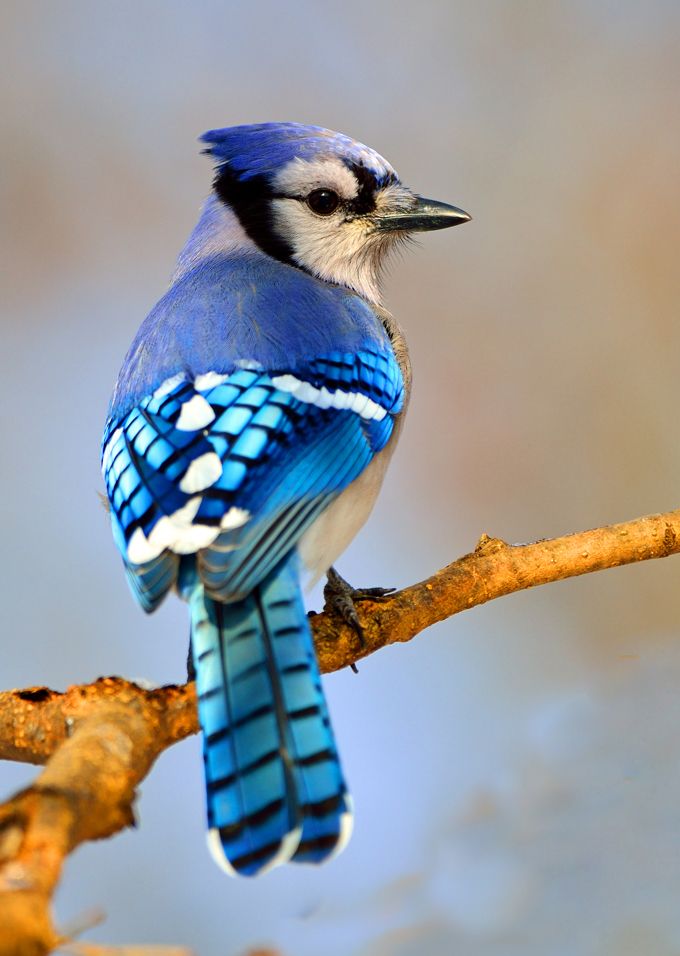
Will imitate the owner
will be your alarm clock
Reminds him that he is also a member of the family
Will help with the housework
Or just a reminder that it's time to get out
Think before picking up a fledgling:
Can you provide predominantly free-range poultry?
Gavryusha lives in our apartment. A fairly spacious cage is used only as a house where he eats, drinks and stays for a short time when no one is at home, otherwise a "hurricane" will sweep through the apartment. In the warm season, he goes with us to the dacha, runs around the site (because he really can’t fly). It can also be kept on a glazed balcony or loggia. A vacuum cleaner and a rag are a daily addition to our boring life. Next summer we will send him to the dacha for the whole season, making a spacious aviary there.
Parasites.
Ticks, feather-eating, blood-sucking flies are parasites that are quite common in birds and are not easy to exterminate.
Gavrik was found to have a feather-eater almost immediately after the appearance of the bird in the house. It is not dangerous for humans, but because of it the bird constantly itches terribly and loses feathers. What only recommended preparations did not try to remove this rubbish, only after 3 months of general torment, as the most extreme option, we bathed it in sunflower oil. Forgive us animal rights activists, but it helped.
Wakes up with the sunrise, and certainly won't let you lie in bed, even if you cover the cage with a blanket, don't cover it - it's not a parrot for you. With his cry, he will wake up not only you, but also the neighbors.
Sunbathing is an essential part of keeping a jay. So she receives vitamin D, which promotes the absorption of calcium.